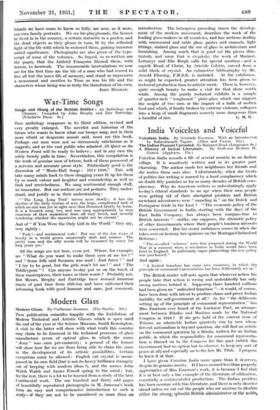Modern Glass
Modern Glass. By Guillaume Janneau. (The Studio. 30s.) This publication coincides happily with the Exhibition of Modem Technical and Artistic Glasses which is open until the end of the year at the Science Museum, South Kensington. A visit to the latter will show with what truth this country may claim to be foremost in the technical processes of glass manufacture (even of optical glass, in which the name " Jena " was once pre-eminent) ; a perusal of the former will show how far we are from being able to claim the same in the development of its artistic possibilities. Certain exceptions must be allowed : English cut crystal is unsur- passed in its own field (but is not its heavy brilliance strangely out of keeping with modern ideas ?), and the names John Walsh Walsh and James Powell spring to the mind ; but, for the rest, there is a lot to be learned from a study of the best Continental work. The one hundred and thirty odd pages of beautifully reproduced photographs in M. Janneau's book form an easy and comprehensive introduction to such a study—if they are not to be considered as more than an introduction. The letterpress preceding traces the develop- ment of the modern movement, describes the work of the leading glass-makers in all countries, and has sections dealing with ornamental and table glass, pastes and enamels, light fittings, stained glass and the use of glass in architecture and furnishing. Among much that is good (of the pieces illus- trated), and some that is exquisite, the work of Marinot, Lobnneyr and Elis Bergh calls for special mention—and a superb Head of Christ, by Aristide Colotte, carved from a solid block of crystal. An exhaustive bibliography by Mr. Arnold Fleming, F.R.S.E. is included. At the exhibition, as might be expected, greater attention has been given to technical production than to artistic merit. There is, however, quite enough beauty to make a visit for that alone worth while. Among the purely technical exhibits is a sample of quarter-inch " toughened " plate-glass which can support the weight of two men or the impact of- a ladle of molten lead and which, if finally broken by extreme violence, collapses into a heap of small fragments scarcely more dangerous than
































































 Previous page
Previous page